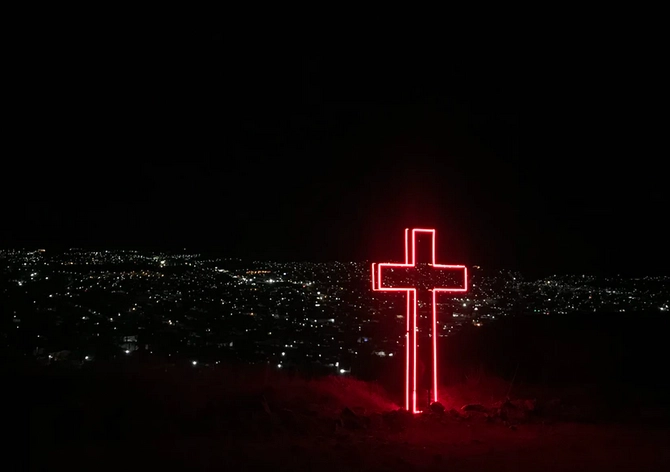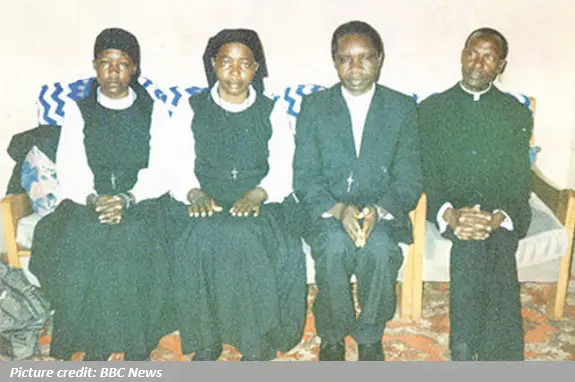The Movement for the Restoration of the Ten Commandments of God was the name of a religious movement that originated in Uganda in the 1980s – following alleged visions of the Virgin Mary, and its subsequent events.
The movement saw its number of followers swell in the following years, but in 2000, a mass murder of the movement’s followers resulted in the group’s abrupt end – following false claims of an imminent apocalypse.
The mass deaths caused an uproar and anger towards the cult leaders. In subsequent years, the movement has been referred to as a cult. In this article, we look at the history of the group and the tragic demise of its hundreds of followers.
Visions of Virgin Mary
The movement can be traced as far back as 1960, when a man named Paolo Kashaku claimed to have seen a vision of his daughter Evangelista – who had recently passed away. Evangelistsa purportedly said to her father that he would soon see a vision of heaven.
Almost thirty years later, this prediction apparently came true, as Paolo said he witnessed visions of Jesus, the Virgin Mary and Saint Joseph. His daughter – Credonia Mwerinde – reputedly had similar visions. Her father Paolo urged her to spread the experience around Uganda – an order which the Virgin Mary instructed.
In doing so, Mwerinde met Joseph Kibweteree – a man that also said he’d seen a vision of the Virgin Mary a few years earlier. The duo met in 1989, and soon after decided to form a new movement – naming it The Movement for the Restoration of the Ten Commandments of God.
The contents of the visions are believed to have revolved around an apocalypse that was due to happen soon. The aim of the movement was to spread the word of the visions of the Virgin Mary.
Followers were told the need to follow the Ten Commandments in order to avoid eternal damnation following the apocalypse. It didn’t take long for the group to achieve support from many people.
At the time of the movement’s formation, Uganda was in a state of disarray, having been affected by Civil War, an outbreak of AIDS and an authoritative and brutal regime from the President of Uganda – the infamous Idi Amin.
The Catholic Church had struggled in preceding years, having attracted many scandals and accusations of wrongdoing. Many religious movements were founded in the aftermath, with membership of the Catholic Church in the country dwindling fast.
This combination of factors was the perfect storm for a new movement. It made The Movement for the Restoration of the Ten Commandments of God a very popular organisation to follow.
Growth
The group were based in the Ugandan district of Kanungu. Paolo Kashaku – the person that had originally had visions of the Virgin Mary, gifted a significant portion of his land to allow the group to have a base, but soon after died. The group were therefore based in a secluded location, and were shut off from the outside world.
A key moment in the group’s rise was attributed to the arrival of Dominic Kataribabo – a highly-revered academic who returned to Uganda from the United States. Membership in the movement continued to grow throughout the 1990s.
Kataribo joined Mwerinde and Kibweteree in leading the group. Over the following years, four others named Joseph Kasapurari, Joseph Nymurinda, Ursula Komuhangi and John Kamagara would complete the seven-strong leadership group. They would allegedly continue to communicate with the Virgin Mary.
When members joined, they would give up their possessions, which were then used to generate money for the movement. They would then follow the teachings of a book entitled ‘A Timely Message from Heaven: The End of the Present Time’. Followers would need to study the book closely.
As mentioned, particular emphasis was based on the following of the Ten Commandments. At times, the group would only communicate by sign language – such was their fear of breaking some of the commandments. Fasting, abstinence and regular worship were all followed.
The Movement’s members happily resided in large plantations within the Kanungu district. Primary Schools, medical centres and places of worship were all constructed for use. In 1997, the group had a total membership of just under 5,000 people.
The Apocalypse
Mwerinde and her fellow leaders claimed to continue to communicate with the Virgin Mary throughout the 1990s. This led to their belief that the apocalypse would fall on 31st December 1999 – just before the new millennium.
The entire movement became ready for the imminent apocalypse – confessing their sins, selling off possessions and engaging in group activities to be prepared. Any remaining assets were sold, with members handing over the proceeds to the leaders of the movement.
Yet the 1st January 2000 followed, and no apocalyptic event took place. In the direct aftermath, the movement lost scores of members, with some doubting the veracity of the movement’s beliefs.
What happened next isn’t entirely known. Investigators have largely settled on the following account. It is believed that members of the group rebelled against the leadership – and demanded money for lost possessions. The group’s leadership reacted by identifying a new date for the apocalypse – this time the 17th March 2000.
Mass deaths
Membership numbers steadied in response to this new date. But over the next few weeks of 2000, it is believed a mass purge of members was implemented, with deaths occurring at multiple sites.
When the 17th March arrived, the group were once again prepared for the apocalypse. An enormous celebration took place during the night, as members celebrated what they believed was their final day.
But at some point, an enormous explosion caused a large fire that left all 530 attendees of the celebration dead. No one was able to escape the building, as windows and doors had all been nailed shut from the outside.
Investigations
The Police launched a large investigation, and found that Dominic Kataribabo – the academic who had left USA to join the movement – had bought 40litres of sulphuric acid in the build-up to the celebration, it is believed that this acid was responsible for starting the large fire.
Yet matters got worse when the Police found several hundred more bodies across Uganda – all of which were linked to the movement. Aside from the Kanungu district, a large farm owned by Nymurinda had 81 dead bodies.
A further 155 bodies were discovered at a large estate owned by Kataribabo, with many showing stab wounds. A further 159 bodies linked to the movement were found across two other locations.
Many appeared to have been killed up to weeks before the fire on the 17th March. The vast majority had been poisoned, investigations found. The Police settled on a final death toll of 924 people.
Investigators believed that the Movement’s leadership perished in the main fire on the 17th March – though some believe that the leaders fled just after intentionally starting the fire.
Reactions
Originally, the suspicion was that the Movement was a Doomsday cult which had carried out a mass suicide. But after investigations, the Police concluded that a mass murder had been committed by the leaders of the movement.
They thought that the 17th March was used as a date of murder, rather than as that of an apocalypse. It was also unclear as to whether or not those that had orchestrated the murder were on the run, or had died.
The Ugandan government were furious with the event, and blasted the group for using the auspices of a Religious group to instead exploit vulnerable members. They denounced the murderers as “diabolic, malevolent criminals masquerading as religious people”.
It has never been clear how a relatively normal group of people turned into a murderous sect. Interviews from those who knew of the leaders before the murders have suggested that the leaders were not seen as “evil”. It isn’t known what happened, when, or why.
In the intervening years, further details have emerged about the leaders. Credonia Mwerinde was a former prostitute, while Dominic Kataribabo had been excommunicated from the Catholic Church. Joseph Kibweteere is believed to have been treated for Bipolar Disorder around the time of the murders.
The trio of Mwerinde, Kataribabo and Kibweteere have been seen as the main three leaders – and have attracted the most criticism in recent years. They are now all viewed as callous murderers that cruelly led hundreds of people to their deaths.
Since these events, subsequent investigations have concluded that the leaders may actually still be alive. International arrest warrants have been issued. There has been little suggestion of where they are residing, if at all. It is also unknown as to whether or not they ever be found. No arrests have ever been made in connection with the deaths.

The Takeaway
Clearly, the death of almost 1,000 people is a tragedy. It is even worse that those that died believed that they were following the words of the Virgin Mary. While it can never be disproven that they weren’t, it appears they were exploited by a gang of people who used their supposed visions as an excuse to implement a structure where they lived a life of relative ease.
Many questions relating to this group will never be answered. Unfortunately, the case of the Movement for the Restoration of the Ten Commandments of God was not an isolated event, with several other groups resembling a cult carrying out similar actions.















































